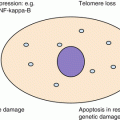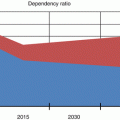Basic activities of daily living
Independence = 1
Dependence = 0 (with supervision, direction, personal assistance, or total care)
Instrumental
activities of daily living
Independence = 1
Varying degrees of dependence or need of significant assistance = 0
Advanced activities of daily living
Bathing
Dressing
Using telephone
Occupational
Toileting
Shopping
Recreational
Transferring
Preparing food
Travel
Continence
Housekeeping
Feeding
Doing laundry
Managing transportation
Managing medications
6 points: patient independent
0 points: patient very dependent
Managing finances
Mr. J’s functional decline was reflected by recurrent hospitalizations and inability to manage IADLs and falls. Upon examination, his external auditory canals are occluded by cerumen. A cognitive assessment reveals moderate decline in memory and executive function. His gait is unsteady. His wife has taken on the role of caregiver and the burden of additional IADLs.
11.7 Comprehensive Geriatric Assessment
Recognition of the complex interaction of age-related physiologic changes, multiple comorbid illnesses, and functional stressors helps determine the health-care needs of older adults. Many older persons with multiple chronic conditions have daily symptoms, use multiple medications, visit several health-care providers, and require assistance with their activities of daily living (ADLs). Such individuals are likely to utilize various health-care settings such as the emergency department (ED), acute care hospital, rehabilitation, and nursing home. They are at risk of poor health outcomes and functional decline.
The ambulatory clinic is an ideal setting for comprehensive assessment that addresses domains beyond the usual medical conditions [9]. This comprehensive assessment fosters understanding of the complex interplay between medical, social, psychological, and value factors and elucidates opportunities for interventions to bolster independent function and support patient and family goals for care [10] (see also Chap. 10).
The comprehensive assessment is often performed with participation of multidisciplinary health professionals, depending on the size of the clinic team. In some health systems, geriatric clinic is a referral clinic for episodic consultation, while in others geriatric clinic providers become the primary care providers for older patients with complex medical and psychosocial issues. In many geriatric clinics, a nurse practitioner, social worker, and nurse case manager are part of the core team. Nonclinical office staff may assist in information gathering and screening. Other health professionals (pharmacist, physical therapist, psychiatrist, or psychologist) may be a part of the team. An interdisciplinary approach facilitates comprehensive care management, coordination of services, optimal medication management, and individualized care plans for patients and their caregivers. Information about the patient’s goals, values, and preferences for care is a major component of person-centered care and guides providers to tailor plans of care.
11.8 Assessment Tools
Rapid screening tools are available to screen various domains of geriatric assessment [11] (see Chap. 10). These tools identify concerns and help target assessments. Strategies to optimize efficiency include using pre-visit questionnaires, initial screening by ancillary staff, and spreading out screening of various domains over multiple visits.
Mr. J’s performance on the Mini-Cog showed 0/3 recall and an abnormal clock draw, confirming impaired memory and executive function. The repeated hospitalizations likely result from his inability to manage his medications destabilizing his chronic conditions [12].
11.9 Medication Management
Medication reconciliation is a critical task. Patients or caregivers should bring to each visit either the medications themselves or a comprehensive list of all (e.g., prescription and over-the-counter) medications, including supplements, with doses. The most common classes of medications implicated in ED visits for older persons are oral antiplatelet medications, oral hypoglycemics, insulin, and warfarin [13]. One commonly used guideline for medications to avoid is the Beers Criteria [14].
11.10 Screening and Prevention
Increasing evidence is available to guide screening prevention in older persons. In the USA, older persons receive only about 50% of recommended care [15]. Screening for hypertension, diabetes mellitus, breast cancer, glaucoma, osteoporosis, and colorectal cancer is generally recommended. Prostate cancer screening is more controversial but is generally recommended for men over 50 whose life expectancy exceeds 10 years. Limitations in life expectancy, health status, and preferences for care all influence decisions about screening and preventive care. A coordinated effort to prevent falls in older adults has been recommended by the World Health Organization and many other agencies recognizing the personal and societal cost of fall-related injuries [16]. This report describes the importance of building awareness of falls prevention and treatment, improving the assessment of each individual, and facilitating culturally appropriate intervention to reduce falls among older adults [17–19].
While the US Preventive Services Task Force (USPSTF) does not recommend screening older adults for cognitive impairment, it is important to recognize signs of cognitive decline and to conduct further assessments [20].
The immunization status should be checked and acted upon as needed (Table 11.2).
Table 11.2
Prevention and screening for older adultsa
Healthy lifestyle | |||
Physical activity | Aerobic Strength Flexibility Balance | Exercise benefits persons of all ages and should be tailored. US Department of Health and Human Services. Healthy People 2020 at www.healthypeople.gov (Accessed 18 Jan 2016) | |
Tobacco cessation | Screen for smoking | Counsel on how to quit if they currently smoke | |
Alcohol | Specific question about frequency and quantity | Physician recommendations effective | |
Aspirin | Benefits may differ for men and women | Discuss with those at risk for cardiovascular disease | |
Immunizations | |||
Tetanus | Booster doses recommended every 10 years by USPSTF | Tdap (tetanus, diphtheria, pertussis) recommended once for those over 65 | |
Influenza | Recommended annually | ||
Pneumococcal | Revised recommendations available | 23-valent polysaccharide vaccine and 13-valent pneumococcal conjugate vaccine available | |
Herpes zoster | Recommended for immunocompetent older adults | Recommendations vary | |
Cancer screening | Decisions should be based on the benefits, risks, and preferences of each individual | ||
Prostate | Based on individual specific factors | ||
Colorectal | Screening recommended | ||
Breast | AGS recommends avoid screening if life expectancy is less than 10 years | ||
Cervical | Cervical cancer is rare in older women who have been previously screened | ||
Lung | Consider for smokers with >30 pack years of smoking who are between 55 and 80 | ||
Cardiovascular screening | |||
Blood pressure | Screen annually or biannually | ||
Lipids | Can stop screening at 65 if prior screening negative | ||
Abdominal aortic aneurysm | One-time ultrasound examination in men 65–75 who have ever smoked | ||
Functional | Functional assessment | BADLs IADLs Gait speed | Guides clinician to focus on conditions that impact function and quality of life |
Visual | Evidence lacking | ||
Hearing | Evidence lacking | ||
Psychosocial | |||
Cognitive | Mini-Mental Status Exam Mini-Cog Clock Drawing Test Memory Impairment Screen Saint Louis University Mental Status (SLUMS) Examination [37] Montreal Cognitive Assessment (MOCA) [38] | Not recommended for those without memory complaints or evidence of functional decline | |
Depression | Over the past 2 weeks, have you felt down, depressed, or hopeless? Over the past 2 weeks, have you felt little interest or pleasure in doing things? | Recommended by USPTSF and ACOVE | |
Osteoporosis | Recommended with varying specifics | ||
Nutrition | Nutritional assessment | Evidence lacking | |
Vitamin D | Recommend 800–1000 IU daily intake Evidence lacking to guide screening | ||
Multivitamins | Evidence lacking | ||
Falls/mobility | Screen for falls | ||
Continence | ACOVE recommends screening question | ||
Medication use | ACOVE recommends the following: 1. Maintain complete list of Rx and OTC 2. Review at each visit 3. Assess for interactions, duplication adherence, and affordability 4. Assess for classes associated with adverse effects 5. Minimize anticholinergics |






